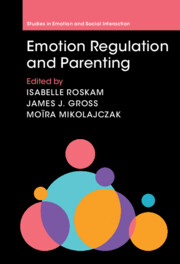Book contents
- Emotion Regulation and Parenting
- Studies in Emotion and Social Interaction
- Emotion Regulation and Parenting
- Copyright page
- Contents
- Figures
- Tables
- Contributors
- Preface
- Part I Conceptual Foundations
- Chapter 1 Parenting Science and Emotion Regulation: Principles, Effects, Determinants, and Supports
- Chapter 2 Emotion Regulation in Self and Others
- Part II Influence of Parents’ Emotion Regulation on Parenting
- Part III Influence of Parenting on Child Emotion Regulation
- Part IV Current Trends
- Index
- Studies in Emotion and Social Interaction
- References
Chapter 1 - Parenting Science and Emotion Regulation: Principles, Effects, Determinants, and Supports
from Part I - Conceptual Foundations
Published online by Cambridge University Press: 05 January 2024
- Emotion Regulation and Parenting
- Studies in Emotion and Social Interaction
- Emotion Regulation and Parenting
- Copyright page
- Contents
- Figures
- Tables
- Contributors
- Preface
- Part I Conceptual Foundations
- Chapter 1 Parenting Science and Emotion Regulation: Principles, Effects, Determinants, and Supports
- Chapter 2 Emotion Regulation in Self and Others
- Part II Influence of Parents’ Emotion Regulation on Parenting
- Part III Influence of Parenting on Child Emotion Regulation
- Part IV Current Trends
- Index
- Studies in Emotion and Social Interaction
- References
Summary
Emotions and emotion regulation constitute essential constituents of parenting. This chapter assesses central features of parenting through the lens of emotions and emotion regulation. Substantive topics include relations between emotions and emotion regulation in parenting, principles of parenting and emotion regulation, parenting direct and indirect effects in emotion regulation, determinants of emotion regulation in parents (and children), and supports for parent and child emotion regulation.
Keywords
- Type
- Chapter
- Information
- Emotion Regulation and Parenting , pp. 3 - 34Publisher: Cambridge University PressPrint publication year: 2023
References
- 1
- Cited by



